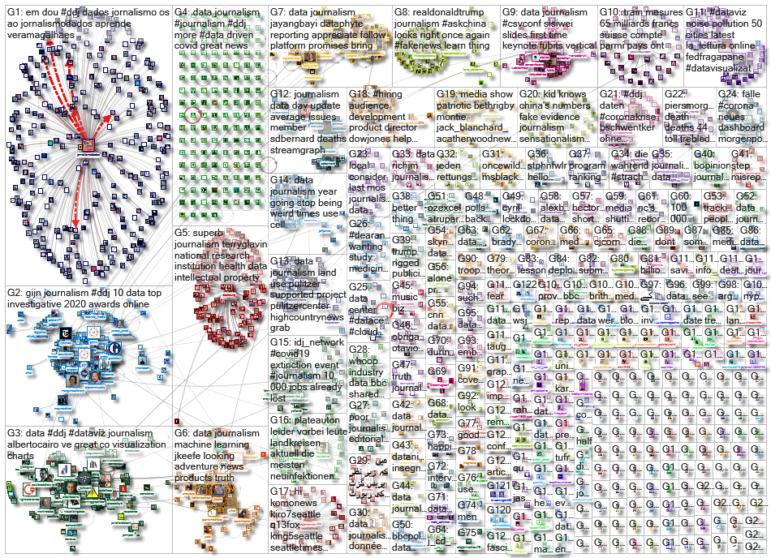Throughout the coronavirus pandemic, we’ve seen heated debate on whether to best solve the health crisis through “herd immunity” — the indirect protection that occurs when much of a population becomes immune to infection. Our NodeXL #ddj mapping from May 11 to 17 finds FiveThirtyEight creating a simulation calculator which shows that getting to herd immunity without a vaccine isn’t quite that simple; The Marshall Project tracking COVID-19 cases and deaths in prisons across America; the BBC’s Media Show highlighting data journalists as the media’s latest rock stars; and Istories and MediaZona examining elder abuse in Russia, which experts fear may worsen during the pandemic with so many people staying home.
Herd Immunity Debate
FiveThirtyEight explains that getting to herd immunity without a vaccine may not be easy. A number of variables can affect when herd immunity is reached — and what it costs to get there — and they vary depending on the disease. The team at FiveThirtyEight created a simulation calculator (not specific to COVID-19) that shows how a theoretical disease — Fictionitis — would play out in a population that has never encountered it before and does nothing to try to stop it.
Getting to herd immunity without a vaccine isn’t a simple thing. https://t.co/y7CBr4vb5y pic.twitter.com/3Y3Jab6Hv7
— FiveThirtyEight (@FiveThirtyEight) May 13, 2020
Coronavirus in Prison
Since March, The Marshall Project has been tracking COVID-19 cases and deaths among inmates and staff in prisons across the United States. Find out how the virus has affected correctional facilities state by state by using their interactive chart.
The toll continues to mount: follow @MarshallProj tracker to see infections, deaths, testing rates in prisons X-country — the incarcerated and staff. Cheers to @katiepark @ultracasual @Weihua_Li1 and @MarshallProj staff + @AP https://t.co/A9gUv4Fo8w
— Susan Chira (@susanchira) May 15, 2020
Data Journalists: Media Rock Stars?
Data journalists used to be a niche part of the news industry. But now due to the pandemic, they have become “rock stars of the news business,” says the BBC’s Media Show. Radio presenter Andrea Catherwood interviews some rising stars about the increasing popularity of data journalism.
Yet to listen to this… but I am liking the hypothesis 🎸🎵https://t.co/vsNoGRG9Yk
— Pete Sherlock (@petesherlock79) May 19, 2020
Best Practices for the Public Health Beat
Health reporting that misrepresents scientific findings can erode public trust in science, which in turn could fuel movements like climate change denial and anti-vaccination campaigns. On datajournalism.com, investigative health reporter Aneri Pattani explains how to better understand the different types of studies, challenge their findings, and report on them accurately. The piece is also available in Turkish.
Health reporting presents a real opportunity to provide a public service, if journalists manage to navigate around the minefields of hyperbolic claims, complex medical trial data, and potential conflicts of interest. https://t.co/Uvr4y0Mp7mhttps://t.co/Uvr4y0Mp7m
— Hussein Kassab (@HSIENK) March 18, 2020
Where New Yorkers Moved to Escape COVID-19
When COVID-19 hit New York, many people living in the city’s wealthiest areas fled their homes. The New York Times pieced together where these residents moved by looking at mail-forwarding requests received by the national postal system. In April, the number of requests went up to 81,000, twice the number compared to 2019. Also, in the NYT’s coronavirus coverage, here are five ways to monitor the coronavirus outbreak in the US, and the country’s latest case numbers.
New Yorkers, many of them wealthy, fled the city when the outbreak hit.
Where did they go? Here's what we know.https://t.co/CZXzAmTTy1— Cliff Levy (@cliffordlevy) May 17, 2020
Abuse of the Elderly
The coronavirus pandemic has driven much of the world’s population to stay at home, but home may not be the safest place for the most vulnerable in our societies. According to human rights activists in Russia, the number of domestic violence cases has increased. To shed light on this issue, Istories and MediaZona examined publicly available court sentences for violent crimes against the elderly committed before quarantine measures were introduced.
«Сын избил её и угрожал убить после возвращения с рыбалки». Дата-исследование о насилии над пожилымиhttps://t.co/yZkNs3ZCQV
— Olesya Shmagun (@Shmagun) May 7, 2020
Excess Deaths Tracker Data Repository
The Economist has been tracking COVID-19 excess deaths in several countries for weeks now, highlighting the problem of under-counting the pandemic’s true number of fatalities. Now, the publication has released the data behind its tracker, plus the code the team used to clean, analyze, and present the numbers. Find it on Github.
For several weeks @martgnz and myself have been cleaning, analysing and presenting this data on our tracking page @TheEconomist, which provides interactive charts and is free to read. (2/5) https://t.co/v3x8RZRoCX
— James Tozer (@J_CD_T) May 16, 2020
Noise Pollution and Hearing Loss
Data visualization designer Federica Fragapane created a beautiful work showcasing data on noise pollution and hearing loss in 50 different cities.
Noise pollution in 50 cities — my latest #dataviz for @La_Lettura is now online! https://t.co/bsOhVuEdQQ#Datavisualization #infographic #ddj pic.twitter.com/kBMtybQ8gK
— Federica Fragapane (@fedfragapane) May 12, 2020
Intro to Machine Learning
The Google News Initiative released an Introduction to Machine Learning course that will teach journalists about the potential of machine learning and explore how it can be used responsibly to enhance journalism.
🚨The @GoogleNewsInit Training Center has a new course on #MachineLearning created by …check notes… me! 🙋♂️https://t.co/JX5QtZPU01
Couldn't have done it w/out @tomvandeweghe & his team at @vrtnws, @MrVincentRyan & many others. Check it out and do let me know your feedback! pic.twitter.com/eXncU3BRWU— Mattia Peretti (@xhgMattia) May 7, 2020
Layoffs at Quartz and Other Newsrooms
The news industry’s finances were already reeling before COVID-19, but now the pandemic is leading to major layoffs. Among those affected is Quartz, which saw nearly half of its staff (80 out of 188 roles) let go, including data journalists John Keefe, Jeremy B. Merrill, Youyou Zhou, and Daniel Wolfe. Their farewell tweets saw many from the community sending sympathies over Twitter. Cuts were also announced at other newsrooms.
A prescient doodle from last week.
Well, I wasn't furloughed, but I was laid off. Joining the many talented coworkers of @qz today in signing off.
For me it was a dream job where I was encouraged to bring my weird and tell data driven stories 💙 pic.twitter.com/1pZy89MGo9
— Daniel Wolfe (@sadbumblebee) May 14, 2020
Thanks again to Marc Smith of Connected Action for gathering the links and graphing them. The Top Ten #ddj list is curated weekly.
 Eunice Au is GIJN’s program coordinator. Previously, she was a Malaysia correspondent for Singapore’s The Straits Times, and a journalist at the New Straits Times. She has also written for The Sun, Malaysian Today, and Madam Chair.
Eunice Au is GIJN’s program coordinator. Previously, she was a Malaysia correspondent for Singapore’s The Straits Times, and a journalist at the New Straits Times. She has also written for The Sun, Malaysian Today, and Madam Chair.

